Jean-Luc Solandt: diving into marine conservation Inspire article
Marine biologist Jean-Luc Solandt tells Karin Ranero Celius about his commitment to study and preserve one of the world’s biggest treasures: the ocean.
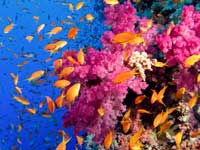
(Anthias)
Image courtesy of PBorowka /
iStockphoto
Jacques Cousteau’s beautiful images of colourful and bizarre underwater sea life have inspired millions of people around the globe – including Jean-Luc Solandt. “I became interested in science after learning about Cousteau’s explorations; they made the marine world seem smaller – yet wondrous.” These days, as the biodiversity policy officer at the Marine Conservation Societyw1, Jean-Luc Solandt helps to safeguard this wondrous world.
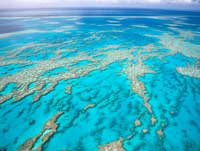
Barrier Reef in Australia
Images courtesy of mevans /
iStockphoto
At school in London, Jean-Luc found science breathtaking, especially anatomy and functional design. As his passion and interest for science grew, he did a marine biology degree at Liverpool University, UK, and then spent a year volunteering on the Great Barrier Reef in Australia, where he surveyed reef fish and monitored the fecundity of corals, witnessing the mass spawning of hard corals.
“The reefs of the tropic are similar to the great plains of the Serengeti, but instead of the large numbers of ungulate [hoofed] grazers, these are replaced by colourful parrotfish and surgeonfish, which are vital for keeping the algae in check and allowing the hard corals to grow. In a healthy reef system, the balance between these herbivores and the algae are vital to keep the coral healthy.”
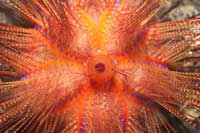
radiata
Images courtesy of ifish /
iStockphoto
Back in the UK, Jean-Luc pursued a PhD at the University of London, doing his fieldwork in Jamaica, where the fish herbivores were (and still are) being eradicated by over-fishing. In the absence of fish, the spiny urchin, Diadema antillarum, was essential to keep the algae in check and give the coral space to grow. In 1990, however, a disease nearly wiped out this spiny urchin, leaving the reef ungrazed. Between 1995 and 1998, as the population recovered, Jean-Luc studied the interaction between the spiny urchins, algae and other reef species.
His growing interest in marine conservation then led him to Tanzania to work as an expedition scientist for Frontierw2 (a UK-based conservation expedition organisation), and then to the Philippines and Fiji with Coral Cay Conservationw3. His responsibilities included training the volunteers – many of whom knew little about marine biology. They soon learned, however, to identify more than 75 fish species and 40 coral species, as well as many other invertebrates that they then recorded during scuba surveys.
“On a typical day, you wake up at six in the morning, organise the dive, meet the volunteers, lecture them, tend to sores and headaches, go on the dive, record and enter the data, lunch on rice and beans, fill the air tanks, teach the volunteers, go on a second dive, go into town to resupply fuel, food and the repair kit, and then carry on entering data,” Jean-Luc says.
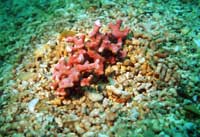
broken piece of maerl
surrounded by dead maerl
gravel
Image courtesy of Phil Lockley
These were months of very long days and hard work, but with a very important purpose: to recommend areas that needed protection, something that Jean-Luc became increasingly involved in. It was the success of these recommendations – including the establishment of the Danjugan Islands Marine Reservew4 – that encouraged him to dive further into applied conservation work – campaigning for UK marine protected areas at the Marine Conservation Societyw1.
The oceans harbour many diverse and co-existing ecosystems, and have always been a dependable source of food for humans – but the vulnerability of these ecosystems is becoming increasingly evident. As shown by recent data, “commercial fish stocks have been reduced by about 95% in UK waters alone in the past 100 years [Thurstan et al., 2010],” notes Jean-Luc. Moreover, 88% of Europe’s fish stocks are overfished or depleted. For this reason, the Marine Conservation Society campaigns worldwide to establish areas where marine wildlife can recover and flourish. These could either be marine protected areas, in which one or more features are protected, or marine reserves, which offer the highest level of protection: no fishing or catch of any kind, and no dumping, dredging or other modification of the environment.
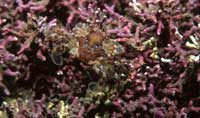
covered in maerl. Maerl is a
rare calcareous, reef-
forming alga, which in
English coastal waters is
only found near Falmouth
in Cornwall
Image courtesy of Sue Scott
“We know from studies abroad that reducing the level of fishing can allow the marine environment to recover somewhat,” Jean-Luc says. “However, this alone is not enough: it is also essential to have marine reserves – and big enough ones.” A good example is the five large Georges Bank marine reserves, which cover a total of 17 000 km2 off the north-eastern coast of the USA, and which have allowed scallop numbers to increase by 2000% and yellowtail flounder (a flatfish) by 500%. Analysis of the effects of 124 international marine reserves have revealed an increase in the biomass of previously exploited species by 446% and in their diversity by 21% (Lester et al., 2009).
Marine reserves not only benefit the ecosystem within the reserve but also affect what happens outside their boundaries. “In a phenomenon called ‘fishing the line’, catches are higher around the edge of the reserve than further away: 73% of the haddock fished in the north-eastern Atlantic is caught within 5 km of the Georges Bank reserve boundaries. This helps fishermen to be more certain of catching fish, whilst reducing their overheads, because they do not have to waste time and fuel searching for fish,” Jean-Luc says. So even the fishermen benefit from the reserve. This effect has also been recorded for lobster and fish catches around small Mediterranean marine reserves (Goñi et al., 2008).
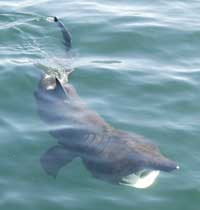
list’ of threatened species of
the International Union for
Conservation of Nature. The
basking shark migrates
thousands of kilometres
Image courtesy of Colin
Speedie
“Small-scale marine reserves have been shown to be beneficial to relatively sedentary species and fish that do not move large distances during their life history. However, to benefit larger, more migratory species such as haddock, we need marine reserves on the scale of the Georges Bank marine reserves.”
For species that migrate between oceans, however, marine protected areas and reserves are of limited use. For the past six years, therefore, Jean-Luc has participated in a project to protect the basking shark, which migrates over huge distances and between oceans. “Basking sharks are the second largest fish in the world. They are planktonic filter feeders, up to 12 m long, and are highly endangered because of their low fecundity (about six pups every two years) and late age of maturity (about 18 years).”
In 2007, the project succeeded in making it illegal to fish or trade basking sharks or their body parts in EU waters. On behalf of the Marine Conservation Society, Jean-Luc records and maps sightings by the general public of basking shark: since 1987, the Marine Conservation Society has compiled more than 12 000 reports of over 25 000 sharksw5. “It is partly due to this data set that there has been such interest in the species, allowing the UK government to support the protection of the basking shark in international waters. So public participation can lead to greater protection for vulnerable species.”
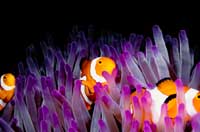
anemone
Image courtesy of JodiJcobson
/ iStockphoto
Jean-Luc is also involved in a wide variety of projects involving the public, such as the Seasearch projectw6, in which volunteer scuba divers record what is living on the sea bed around Britain and Ireland, finding out which are the richest sites for marine life, and which sites need protection. He also helps to run the ‘Your seas your voice’ projectw7, in which members of the public can vote for marine areas (including those outside UK waters) that they think should be protected.
The people who report sightings of basking sharks, vote for a marine protected area or take part in dive surveys are concerned and knowledgeable about the condition of our seas. Unfortunately, most people simply care less about the health of the seas than the health of the land. This is one reason why Jean-Luc believes that science education is vital – to demonstrate that with the help of conservation science, we can have both a more productive fishing industry and healthier seas. Furthermore, he stresses, individuals can make a difference. “To help safeguard our oceans, you can eat sustainably sourced fishw8, vote for a marine reservew7 or support organisations like the Marine Conservation Societyw1.”
References
- Goñi R et al. (2008) Spillover from six western Mediterranean marine protected areas: evidence from artisanal fisheries. Marine Ecology Progress Series 366: 159-174. doi: 10.3354/meps07532
- This article is freely available from the Marine Ecology Progress Series website: www.int-res.com/abstracts/meps
- Lester SE et al. (2009) Biological effects within no-take marine reserves: a global synthesis. Marine Ecology Progress Series 384: 33-46. doi: 10.3354/meps08029
- This article can be downloaded free of charge from website of the Partnership of Interdisciplinary Studies of Coastal Oceans (www.piscoweb.org) or via the direct link: http://tinyurl.com/336rvm6
- Thurstan RH et al. (2010) The effects of 118 years of industrial fishing on UK bottom trawl fisheries. Nature Communications 1: 15. doi: 10.1038/ncomms1013
Web References
- w1 – The Marine Conservation Society is a UK charity dedicated to the protection of the marine environment and its wildlife. See: www.mcsuk.org
- w2 – Learn more about Frontier, the UK’s leading conservation expedition organisation, here: www.frontier.ac.uk
- w3 – Coral Cay Conservation is an award-winning specialist in coral reef and tropical forest conservation. See: www.coralcay.org
- w4 – To learn more about the Danjugan Islands Marine Reserve, see: www.prrcf.org
- w5 – Basking Shark Watch, the Marine Conservation Society’s report, can be downloaded from the society’s website (www.mcsuk.org) or via the direct link: http://tinyurl.com/3yaxbaf
- w6 – If you would like more information about Seasearch, see: www.seasearch.org.uk
- w7 – For more information about the Marine Conservation Society’s ‘Your seas your voice’ project, see: www.yourseasyourvoice.com
- Some scientists recommend that 20-30% of ocean habitats should be set aside as marine reserves. Currently less than 0.0005% of UK waters are in marine reserves. As a result of a campaign by the Marine Conservation Society and other organisations, however, the Marine and Coastal Access Act was passed in November 2009, ensuring that a network of marine protected areas will be established around the English coast by 2012. To learn more, see the website of the UK Department for Environment, Food and Rural Affairs (www.defra.gov.uk) or use the direct link: http://tinyurl.com/3yugxxx
- w8 – To find out which fish are sustainably fished, see: www.fishonline.org





